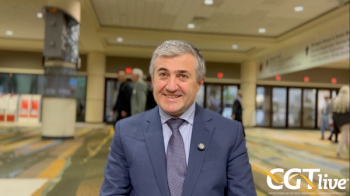
KTE-X19 MCL Application Enters EU Regulatory Pipeline
The European Medicines Agency has validated and is now evaluating a Marketing Authorization Application for the CAR T-cell therapy KTE-X19 for the treatment of adult patients with relapsed/refractory mantle cell lymphoma.
Ken Takeshita, MD
The European Medicines Agency (EMA) has validated and is now evaluating a Marketing Authorization Application for the CAR T-cell therapy KTE-X19 for the treatment of adult patients with relapsed/refractory mantle cell lymphoma (MCL).1
The application is supported by findings from the phase II ZUMA-2 trial (NCT02601313), in which a single infusion of the CAR T-cell therapy led to an overall response rate (ORR) of 93%, including a 67% complete response (CR) rate, in this patient population.2 The responses were assessed by an Independent Radiologic Review Committee (IRRC).
“Relapse rates in mantle cell lymphoma remain overwhelmingly high and there is a significant need for new therapies that may improve patients’ prognosis,” Ken Takeshita, MD, global head of Clinical Development, of Kite, a Gilead Sciences Company, and the developer of KTE-X19, stated in a press release. “The EMA validation of our marketing application brings us closer to delivering on the promise of our industry-leading cell therapy development program, with the hope that we can bring KTE-X19 to appropriate patients in Europe as quickly as possible.”
KTE-X19 consists of an anti-CD19 single-chain variable fragment with a CD3 zeta T-cell activation domain and a CD28 signaling domain. During the manufacturing process, circulating tumor cells are separated from autologous immune cells.
In the single-arm, open-label, ZUMA-2 trial, 74 patients were enrolled and underwent leukapheresis, with 5 patients not receiving the therapy due to manufacturing failures (n = 3) or death from progressive disease (n = 2). Overall, 69 patients went on to receive conditioning chemotherapy and 68 received KTE-X19.
A primary efficacy analysis, which was presented at the 2019 ASH Annual Meeting, was conducted on the first 60 patients enrolled in the study. Overall, KTE-X19 was effectively manufactured for 96% of patients and administered to 92%. The median time from leukapheresis to delivery of KTE-X19 was 16 days.
During the manufacturing process, patients in the study were allowed to receive bridging therapy for progressive disease at the investigator’s discretion. This could include ibrutinib (Imbruvica), acalabrutinib (Calquence), or dexamethasone, but not chemotherapy. Beginning 5 days prior to T-cell infusion, patients received 3 consecutive days of conditioning chemotherapy with fludarabine at 30 mg/m2 plus cyclophosphamide at 500 mg/m2. KTE-X19 was administered as a single infusion at 2 x 106 cells.
The median age of patients was 65 years, with 57% of patients aged ≥65 years. Most patients had stage IV disease (85%) and 56% had intermediate- or high-risk disease. The Ki-67 proliferation index was ≥50% in 69% of patients and 17% had TP53 mutations. Bone marrow involvement was found in 54% of patients, and 56% had extranodal disease. The most common morphologies were classical (59%), blastoid (25%), and pleomorphic (6%).
The median number of prior therapies was 3; the majority of patients (81%) had ≥3 treatments. Almost all patients had received prior anthracycline or bendamustine and 100% of patients had received a prior anti-CD20 antibody. BTK inhibitors had been given to 100% of patients prior to study entry. Furthermore, 37% of patients received bridging therapy, most commonly with ibrutinib (21%). Of those who received bridging therapy, most had higher disease burden prior to infusion of the CAR T cells compared with baseline (92%).
At a median follow-up of 12.3 months (range, 7.0-32.3), results showed that 47% of patients had been followed for ≥24 months. Forty percent of patients who initially had a partial remission (PR) or stable disease transitioned to CRs, with a median time to CR of 3 months (range, 0.9-9.3).
At the time of the analysis, the median duration of response had not yet been reached. Of those reaching a CR, 78% remained in remission at the time of the analysis. For the first 28 patients treated on the trial, the median follow-up was 27.0 months. In these patients, 43% of responders remained in remission, which suggested high durability of response with a plateau in the curve.
Additional data showed that the median progression-free survival (PFS) was not yet reached. The 12-month PFS rate was 61%, with a tail on the curve (95% CI, 45%-74%). The median overall survival (OS) was also not reached, with a 12-month OS rate of 83% (95% CI, 71%-91%).
Regarding safety, the most frequent treatment-emergent adverse events (TEAEs) of any grade were pyrexia (94%), neutropenia (87%), thrombocytopenia (74%), anemia (68%), and hypotension (51%). Grade 4 TEAEs included neutropenia (69%), thrombocytopenia (35%), hypoxia (9%), and hypotension (3%). There were 2 grade 5 AEs: the first was pneumonia related to the conditioning therapy and the second was staphylococcal bacteremia due to post-conditioning therapy and the CAR T-cell infusion.
All-grade CRS occurred in 91% of patients, which was grade ≥3 in 15% of patients. The majority of pyrexia, hypotension, and hypoxia events seen in the study were related to CRS. Management for CRS included tocilizumab (Actemra; 59%) or corticosteroids (22%). The median time to onset was 2 days and the median duration was 11 days. All events resolved.
All-grade neurotoxicity was experienced by 63% of patients treated with KTE-X19, with 31% of patients having a grade ≥3 event. The most common symptoms were tremor (35%), encephalopathy (31%), and confusion (21%). This AE was managed with tocilizumab (26%) and corticosteroids (38%) and the median time to onset was 7 days with a median duration of 12 days. There were no cases of grade 5 CRS or neurotoxicity.
There was one case of grade 4 cerebral edema in the study that was confirmed using MRI of the brain. Following intubation, this patient was treated with aggressive therapy, including tocilizumab, siltuximab (Sylvant), high-dose steroids, intrathecal cytarabine plus dexamethasone, mannitol, ventriculostomy, and IV rabbit anti-thymocyte globulin. The neurotoxicity fully resolved for this individual and the CR had remained ongoing for 24 months at the data cutoff.
In December 2019, a biologics license application for KTE-X19 was submitted to the FDA for the treatment of adult patients with relapsed/refractory MCL. The CAR T-cell therapy has also been granted breakthrough therapy designation by the FDA and a Priority Medicines by the EMA.
References
- European Medicines Agency Validates Kite’s Marketing Application for Company’s Second CAR T Cell Therapy [news release]; Santa Monica, CA. Kite. Published January 28, 2020. https://bit.ly/2U5FFwR. Accessed January 28, 2020.
- Wang ML, Munoz J, Goy A, et al. KTE-X19, an anti-CD19 chimeric antigen receptor (CAR) T cell therapy, in patients (pts) with relapsed/refractory (r/r) mantle cell lymphoma (MCL): results of the phase 2 zuma-2 study. Presented at: 2019 ASH Annual Meeting, Orlando, FL, December 7-10, 2019. Abstract 754.
Newsletter
Stay at the forefront of cutting-edge science with CGT—your direct line to expert insights, breakthrough data, and real-time coverage of the latest advancements in cell and gene therapy.

















































